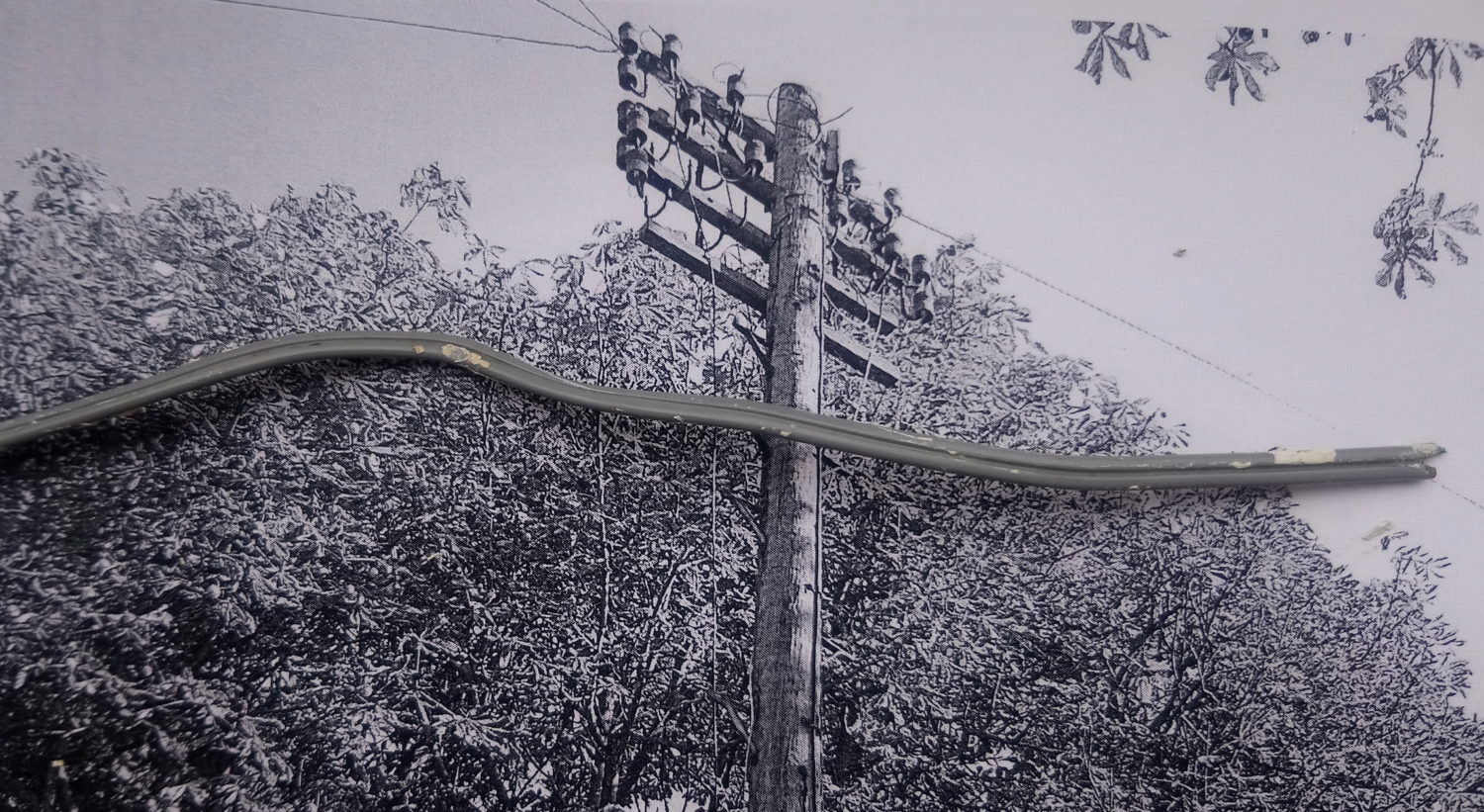What is it?
It connects your house to the telephone pole, via the outside of a building. I recall seeing it first in 1969. It’s quite rare these days, and there’s not much information on-line. “Time for an “Old Grey BT Drop Wire – Some FAQ” blog”, I thought.
What Does It Look Like?
Grey, thin, and “figure of eight” in section.
Why Should I Be Bothered About It?
If you are experiencing slow broadband speeds, the drop wire could be the reason. It was never designed to carry anything but the voltages for phone calls.
I Thought All Drop Wire Was The Same?
Nope! More recent stuff is made of pure copper (for better connectivity), has better insulation, is much stronger, and consists of twisted pairs of wires. See my earlier blog.
What’s The Issue With Twisted Pairs of Wires?
In order for broadband function properly, it needs to run over a twisted pair of wires to avoid interference (with itself!) and hence slower speeds (note to geeks and techie-obsessives- yes, I know this is a simplistic description). Parallel wires in anything running broadband are very bad news indeed. I have seen an instant leap in speed when these kind of non-twisted cables have been replaced. More about cables in my blog here.
What Else Is Bad About It?
As it is around at least forty years old, the insulation on the outside, and between the cores may break down. This will cause water to penetrate and give short-circuits or line noise (a gentle “swishing” sound or a crackle). Not good for streaming the latest Bond movie. Annoyingly, these faults may be intermittent, subject to weather. An engineer may call when everything is running just fine, not find the fault, and charge you for the call-out.
It’s Not Sounding Good So Far. Anything Else?
It’s made of copper-coated steel, therefore will rust and break. Worse still, one core will break, the other remain intact, and your broadband will still work, although at 20% of normal speed. I found some like this recently, with rust-staining around the grey sheath.
And Now, The Good News.
I have discovered via an engineer that Openreach have finally declared it “end of life” and may replace it free-of-charge. (About time, too…). You would need to organise this via your service provider.
But You Said “May”?
Yes. In some cases, if the speed is acceptable (according to them), and the replacement may take some considerable work, they may just leave it (so it has been alleged).
Where Does That Leave Me? Have You Any Suggestions?
Some engineers (allegedly) say that it has been know to fall down mysteriously overnight. This tends to bring matters to a head, and it has to be replaced. I couldn’t possibly comment…
If I can help (but not by making this old grey BT drop wire magically fall down), please be in touch.


Great website! Really informative! Could I have some guidance however? Have broadband and pay for super speeds, yet don’t get them. Also Internet drops every now and then (sporadic but often), including Etherley cable attached PCs (not router issues). Also can be worse when weather changes, I can use it to tell when the weather is going to be different the following day!!! Because the Internet drops many times through the evening! Looked at wiring, have removed everything included land lines but still has issues, the bt cable comes in through the wall into a box, looks like a joint to extend into the hallway where the master box is. Could this wire be faulty? It goes through the cavity in the walls so I cannot see it. Would it be worth replacing it?
Thanks for your kind words.
This is a situation where your master socket really is your friend. If the problem appears upstream from your master socket, that is, on the exchange side (and certainly their responsibility), then it’s over to your provider to sort it out via Openreach. Full stop.
The fact that the fault changes with the weather points to some kind of issue with exposed cabling on the Openreach network. When you have problems again, dial 17070 from a landline, choose “Quiet Line Test” from the menu options, and listen for line noise.
Intermittent faults are notoriously hard to diagnose and fix. However, Openreach need to come and do a “pair quality test”, which would pick up anything obvious yet borderline which may get worse with moisture ingress. Their gadgets will give distance to the fault, which may be a cabinet, pole or joint in a pit.
I hope that this helps. Can I scrounge some feedback/a review in exchange for free helpline support, please? 🙂
This helps me to continue giving free advice.
https://goo.gl/maps/p1n9wxi5T6p
http://www.facebook.com/telecomgreen
twitter.com/phone_engineers
Thanks!
Rob
hi, re your comments on the old grey dropwire, it was actually copper cadmium mix and came in in the early 1970,s, it was not copper coated steel. oddly enough when looking for faults on it they seemed to occur quite often where the cable had been painted with gloss paint. Recently I have been repairing quite a few faults for customers who’d done their own work and had issues several months later. this is due to a type of cable, bt spec cw1308, but it is marked up CCS (copper coated steel) and tends to fail after a few months in service, might be worth mentioning in one of your posts.
I have to agree with your comment made in one post about most electricians not having a clue regarding telecoms wiring, I’ve seen all kinds of bodges, I qualified as a spark 36 years ago when sparking was a proper trade with a long apprenticeship, later on I spent a couple of years with BT as a telephone engineer, then a couple more at Virgin Media doing both telecoms and broadband. Please feel free to contact me if anyone needs any help in the St Helens/Warrington areas. best wishes, Phil
Thanks very much for taking time to comment and clarify. I have also blogged here…
https://telecomgreen.co.uk/home-phone-repair/phone-extension-wiring-which-type-of-cable/
… on the dreaded CCA cable. I may amend this on your advice to include CCS, although I’ve never encountered any. However,I tend to replace anything that looks cheap and nasty, and doesn’t bend like copper straight away.
The BS4807 standard relating to the earlier forms of dropwire seems to cover both CCS and copper/cadmium.
https://nordencommunication.com/en-gb/public/uploads/media/TELEPHONE-DROP-CABLE-No-126-8.pdf
Meanwhile,I will drop you a mail regarding a couple of engineer’s forums I belong to,where other engineers are often looking to pass on work outside their area.
Hi.
I’ve just had a new drop cable replaced and I asked the engineer to run it to the master socket which is about 1.3-1.4 meters run-away from it entering the property.
He was going to connect the new cable to the existing pre 1975 grey cable in a junction box. But I thought it better to replace it all, even though the new cable is significantly larger !
I am now regretting this as the previous cable was very discreet in comparison, running down the wall from the window sill to the skirting and around onto the adjoining skirting, into the master socket.
I’ve read your comments regarding older straight wires and newer twisted ones, where you noticed a significant difference in speed and I would just like to ask if you think I did make the right choice there or for such a short run internally, it really won’t make any difference at all ? Just like the young engineer told me.
Kind regards
Hello,
This cable is now replaced as a matter of procedure by Openreach. They tend not to replace anything unless absolutely necessary, so it obviously is of a concern for future reliability.
Most of this stuff is over 25 years old now. The copper cores are large, and generally of good quality. However, the grey sheath tends to break down and crack. This can cause earth faults and line noise due to shorts between the cores.
Using a small length may not slow things down. However, broadband needs all the help it can get, so ruling out any potential sources of failure is wise.
I am surprised that the engineer brought the drop-wire inside (if I understand your description correctly). It can be covered up with decorative trunking, made by D-Line, available from Screwfix and TLC. An independent engineer would be able to joint it at a convenient point, and run more visually-pleasing internal cable.
I hope that this is useful. Google Reviews are always appreciated.
Rob.